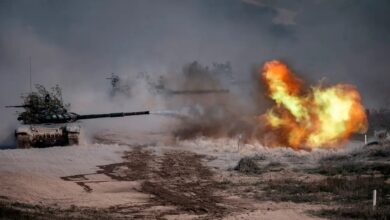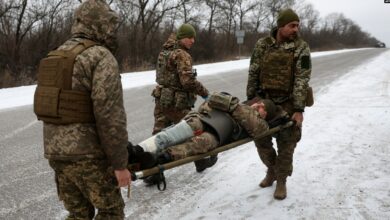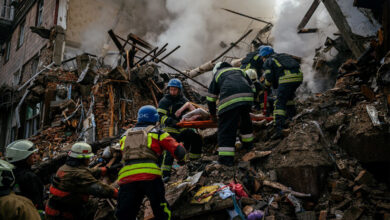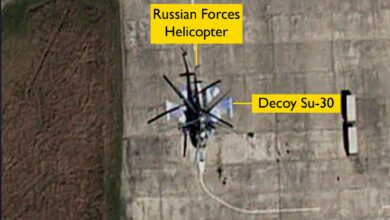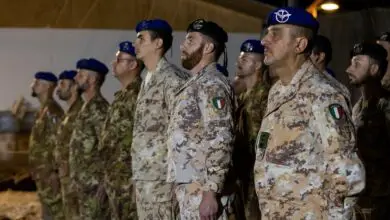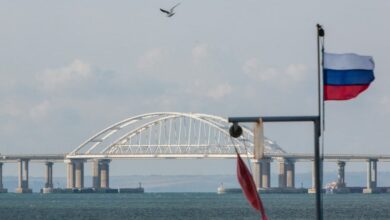Princely ties: The growing Chechnya-Gulf security relationship
Ramzan Kadyrov’s interactions with the Arab world occur in a manner far more befitting a sovereign state than a province of one
Much has been made of Russia’s resurgence in the Middle East in recent years. Following its large-scale military intervention in Syria in 2015, Moscow has increasingly become an attractive destination for Middle Eastern leaders, with regular trips from a cast including Turkey’s President Recep Tayyip Erdogan, Israel’s Prime Minister Benjamin Netanyahu, and leading Libyan warlord General Khalifa Haftar, attesting to Russia’s growing clout in the region.
Another track of engagement with the region has developed in parallel: that of Chechnya.

Chechen leader Ramzan Kadyrov has been perhaps the single most visible Russian official in the Middle East, having developed personal friendships with numerous Arab rulers. Kadyrov has been closely involved with Syria in recent years, spearheading the repatriation of Russian-speaking Islamic State detainees and deploying his soldiers as military police. His role in Libya has recently picked up as well, with his close ally Lev Dengov recently appointed to head a new section of Russian interests there.
But Chechnya’s Middle East engagement appears set for substantial growth in one sector in particular in the coming year: special forces and counterterrorism training. As Russian private military contractors expand their footprint across Africa and the Middle East, Chechen spetsnaz could soon follow in their wake.
Kadyrov’s most frequent and public dealings are with the Arab states of the Gulf Cooperation Council, where he makes frequent visits. For the Chechen leader, the Gulf states are a natural point of engagement: they are authoritarian Islamic states, awash with rentier revenue (albeit derived from a different source – oil instead of Russian federal subsidies), and ruled by a security-oriented clique of leaders who enjoy a strongman image.
Kadyrov has consciously modeled his own rule in much the same way, building a capital replete with prestige projects seemingly designed to emulate Gulf largesse: the planned 102-story Akhmat Tower, slated to be the tallest in Europe, draws evident inspiration from Dubai’s Burj Khalifa.
Chechnya’s leader gets on with his Gulf counterparts equally well. He has made two tours of the region in the past four months alone. In August, he made the hajj pilgrimage to Mecca, stopping in Jeddah along the way, where he met Saudi Crown Prince Mohammad bin Salman and King Salman bin Abdul-Aziz. A trip in November brought him to Bahrain, where he met Prince Nasser bin Hamad Al Khalifa, commander of Bahrain’s Royal Guard, and visited a military base to observe training exercises.
He then stopped in Dubai for the Formula One Grand Prix, where he again met MBS, as well as Turkish chef Nusret Gokce, better known as ‘Salt Bae,’ who fed Kadyrov meat from a skewer in his restaurant. He also held talks with Mohammed bin Zayed, the crown prince of Abu Dhabi and de facto ruler of the United Arab Emirates.

Grozny’s Russian Spetnaz University
These negotiations likely involved discussion of a key new Chechen asset: the Russian Spetnaz University. The massive complex is designed for multifaceted special forces training, from urban assaults to hostage rescue, with the aim of becoming “the largest and most modern military center in the world” of its kind.
Infrastructure ranges from paratrooper and helicopter assault training areas to ship-boarding exercise grounds, as well as a full-scale tactical city for urban scenarios. It will serve as the primary training and exhibitionary grounds for the Chaborz assault vehicle, a combat buggy developed indigenously by Chechen military engineers with the intention of export for forest and desert warfare. Instructors will be drawn from the ranks of the elite Alfa and Vympel assault units of Russian military intelligence (GRU), among the most elite in the country.
In an extensive interview with the Russian military weekly Zvezda in July, the commander of the facility and head of Chechnya’s security forces training, Daniil Martynov, gave further clues as to the intent of the university.
Martynov announced that the facility is expected to become fully operational by summer 2019, with its operatives already participating in specialized exercises across Russia. He cited the strong performance of Chechen special forces at an international competition in Jordan in 2015 as an example of what they will be able to offer to other clients. Martynov confirmed in another interview in October that, starting in 2019, the center will begin training foreign military units.
These first clients are almost certain to be Arab. Beyond the recent meetings and generally close relations, a number of countries have already expressed open interest in such collaboration with Chechnya.
In January, the UAE stated a desire to begin training its units at the center. Kadyrov announced in August, during his trip to Saudi Arabia, that MBS expressed his intentions to train counter-terrorist forces there. During a visit to Chechnya in September, Jordanian prince Mohd Abbas bin Ali bin Nayef visited the center and attended a demonstration of the Chaborz buggy. Jordan is particularly relevant in the Chechen context as the country hosts the largest diaspora population of Chechens in the Middle East (dating back to Ottoman times) many of whom have served in high positions in the country’s military.
None of this should overly surprising. Kadyrov is not the only one with something to gain in this relationship: the Gulf princes also see in him something useful. The Chechen leader has extensive experience in crushing a domestic Islamist insurgency, something that Gulf leaders fear almost pathologically.
He has also managed to instil a strict power vertical over religious interpretation in his republic, coercing the population towards the only state-approved strain of Islam allowed to exist. Amid discussion of how Arab leaders now seek to retrench their conservative, authoritarian regimes against any possible repeat of the Arab Spring, Kadyrov’s cooperation is likely warmly welcomed.
This is all taking place as Chechen servicemen are gaining their first real foreign experience in Syria. As early as 2006, a unit of Chechen soldiers was deployed abroad, serving in Lebanon to safeguard Russian military engineers there.
Over the past two years, they have gained far more experience, with Chechen battalions serving in Syria as military police. This moniker is somewhat misleading: Chechen officials have acknowledged that nearly all of the troops in these battalions have significant combat exposure, battling Chechnya’s own long-running insurgency, and although fighting frontline battles was not their goal in Syria, they were equipped with full combat kit.
This experience and equipment came in handy at least once, when a military police unit was surrounded and nearly overrun in a September 2017 firefight with jihadists led by Hayyat Tahrir al-Sham that saw at least one Chechen soldier killed and numerous others wounded.

Chechen paramilitary roles
Chechen battalions averaging 400-strong have served in Syria on numerous rotations, the most recent of which arrived home on December 7. With likely several thousand Chechen professionals having served in that conflict, Kadyrov’s forces are well-positioned for further expeditionary roles.
And further roles they may have. The past several months have seen a flurry of activity from Russian private military contractors, led by the notorious private military contractor Wagner.
Russian mercenaries are now present in, or preparing to deploy to, over a dozen countries across the African continent, from the Central African Republic to Mozambique. There are persistent rumours about additional deployments in Libya and Yemen, with the former in particular receiving heightened Russian attention recently.
Kadyrov has recently increased his diplomatic involvement in Libya. A visit by Khalifa Haftar’s loyalist militiamen to Chechnya’s new spetsnaz university – or a few Chechens making the trip to their territory – is not far fetched.
But despite their similar profiles, Wagner and Chechen forces exist as parallel structures, not complimentary ones. The vast majority of Wagner fighters are drawn from veterans of the Russian campaigns in Chechnya, fighting some of the very same men who now head the North Caucasian republic.
Wagner expressly forbids the membership of ethnic Chechens, who are seen as untrustworthy – one commander described them as looking for “opportunities to betray [their allies].” The two have served in entirely separate sectors in Syria, with no known overlap or interactions. This division reflects a long-held distrust of Kadyrov and his forces among Russia’s siloviki, or security chiefs – one that occasionally spills over into open animosity.
This situation also mirrors a larger split between Moscow and Grozny, with the latter acting autonomously in ways that are generally beneficial for the former, but not always tightly controlled. The past few months have seen a far more assertive Kadyrov at home, exerting his dominance over Chechnya’s neighbors in the North Caucasus.
Kadyrov’s interactions with the Arab world also occur in a manner far more befitting a sovereign state than a province of one, with references to Russia and Moscow sometimes thrown in seemingly as an afterthought.
In many ways, the greatest similarities between Kadyrov’s personally-loyal Chechen armed forces and Wagner’s private mercenaries is their relation to the Russian state – outwardly loyal and presumably under control, but both with ominous indications of autonomy. Closer security relations with the Arab world are a positive for Moscow. The existence of not one, but two, rapidly-expanding parallel security structures is a far less certain quantity.



